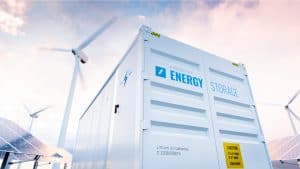The key to a successful energy transition - energy storage
Global Progress in Energy Storage Technologies

Progress in energy storage continues to make the transition away from fossil fuels, and towards a clean and zero-emission energy future, increasingly a fluid evolution.
[See a list of commonplace and emerging energy storage technologies below in this article.]
Renewables coupled with storage produce sources of reliable, efficient, clean, and environmentally friendly energy with dramatically less greenhouse gas emissions (GHGs) than fossil fuels.
The greater cost-efficiency of renewable energy coupled with storage is among the undeniable positive outcomes of recent advancements in new renewable energy and energy storage technologies.
Solar and wind are variable energy sources (as solar doesn't produce energy at night, and both wind and solar produce less energy when subject to weather conditions that limit their potential to generate energy).
As the common saying goes, "...solar does not produce energy when the sun doesn't shine, and wind energy doesn't produce when the wind doesn't blow". Now, this is not always necessarily true 100% of the time, with the most recent breakthroughs in solar energy; such as recent advancements in solar that allow solar photovoltaic panels to be effective in all kinds of sub-optimal weather conditions.
Generally, in order to optimally generate energy from renewables, excess energy from times of peak power generation with renewables should be sent to, and harnessed by, energy storage; thereby addressing the intermittency problem that comes with the variable sources of solar and wind.
Fossil fuels do not tend to have intermittency problems but do produce a huge number of negative externalities, including pollution and GHGs. These negative externalities are created by the combustion of coal, oil, and gas, for energy generation.
The burning of fossil fuels is driving global warming; and in order to avoid the worst consequences of anthropogenic climate change, the world needs to transition away from fossil fuels to renewable energy.
The current state of global energy production and consumption is far from static, however, with recent developments in sustainable energy technologies. There continue to be many recent breakthroughs in sustainable energy technologies, with none more critical than in the field of energy storage.
For cities, states, and countries, to make a successful, accelerated transition to renewables, energy storage needs to be implemented on a global level. It must also be noted that the transition from fossil fuels to renewable energy would be expedited if renewable energy storage was simply more affordable.
Global investment in research, development, and deployment (RD&D), of energy storage technologies, will help determine the pace of the worldwide transition away from fossil fuels. What is needed now throughout the world, is a focus on RD&D of energy storage and clean energy technologies, in order for the global energy transition to be accelerated.
Just as critical are policies to deploy and optimally implement these technologies.
Means of Energy Storage

Widespread future use of variable renewable energy sources such as solar and wind are dependent on the development of effective, affordable means to store excess energy. The type of energy storage ultimately deployed depends on the primary energy source(s) used, location, as well as cost and other factors, and therefore can vary.
Methods of energy storage commonly used today include:
- - Pumped hydro storage
- - Batteries - lithium-ion (li-ion) batteries, flow batteries, and other next-generation advanced batteries
[Pumped hydro has historically been the most prevalent form of energy storage globally, and is still the most used energy storage technology in the world today. Li-ion batteries are, by far, the fastest-growing source of energy storage.]
- - Compressed air energy storage
- - Thermal storage (thermal storage, and applications for excess heat generated in the energy production process, are also discussed in the Solar and Solar Thermal, Combined Heat & Power, and District Heating articles)
- - Flywheels, and other types of mechanical storage
Please see our article on - Future Generations of Advanced Batteries
The following are some of the most promising emerging technologies for energy storage in the future (energy storage technologies with some limited commercial availability today):
- - Hydrogen fuel cells*
- - Ice storage technologies
- - Supercapacitors
- - Vehicle-to-Grid and Vehicle-to-Home
- - Power2Gas
- - Hydrogen; ammonia; chemical energy & storage in gas, liquid, and synthetic forms to store and distribute energy
* [Hydrogen fuel cells are discussed further in the Clean Hydrogen in European Cities (CHIC); H2BusEurope and Clean Hydrogen articles]

Pumped hydro is often the most cost-effective and readily available means of storage for large-scale energy storage projects (depending on the topography of the location in question). Pumped hydro storage (PHS) remains the most frequently used means for storing clean energy worldwide (over 90% of energy storage globally is pumped hydro).
To develop PHS in a suitable location, all that is needed is an area in which both a higher and a lower reservoir can be developed. The lower reservoir in a PHS system acts as the energy storage component. When energy is needed, water from the lower reservoir is pumped up to the top reservoir, run through the hydroelectric turbines (thus producing electricity), and then the water flows back down to the lower reservoir where effectively it is once again energy storage.
An area of existing hydroelectric generation can potentially be developed for PHS as well. An existing hydroelectric generating facility (i.e. a hydroelectric dam) can sometimes be upgraded to create a PHS site. For instance, a hydroelectric dam can be turned into a PHS energy storage site as long as the needed topography is present, and the reservoir systems already exist (such as in an existing hydroelectric dam with a lower reservoir/ or an area that can be suitably developed to be a lower reservoir).
Compressed air energy storage (CAES) is dependent on having an underground cavern, mine, or similar subterranean geological area for storing compressed air. CAES is more location-dependent than pumped hydro, but is also a method of energy storage that is growing in popularity worldwide.
The requisite geological needs for CAES keep this form of energy storage from being widespread, as PHS is. As needed areas for pumped hydro are sometimes already developed for hydroelectric generation, and/ or are relatively easy to discover, PHS is much more widely used than CAES.
Currently, li-ion batteries have a higher energy density, are the least toxic, and are the best battery alternative for utility-scale energy storage (compared to lead-acid, nickel-metal hydride batteries, nickel-cadmium, and other conventional battery types).
Li-ion battery packs, like Tesla's Megapack (illustrated above), can replace natural gas peaker plants to generate a constant source of energy when coupled with variable sources of renewable energy (solar and wind).
Scientists and engineers worldwide will continue to work on next-generation batteries; improvements in li-ion battery technology, as well as efficient alternatives to li-ion. Advancements in, and alternatives to, li-ion batteries include: graphene-based battery technologies, sodium-ion, lithium-sulfur, lithium-air, vanadium redox flow, and other advanced batteries...).
Fuel cell batteries and flow batteries, such as hydrogen fuel cells and rechargeable vanadium redox flow batteries, are promising new emerging long-duration battery technologies. These new long-duration battery technologies both have low environmental impacts (water vapor is the only by-product from hydrogen fuel cells). Both technologies need more R&D before they are cost-efficient enough to be available on a large commercial scale worldwide.
A technology that also seems very promising, but also needs to be developed more to become cost-effective, is using the batteries in electric vehicles (EVs) for storage. The good news is that EVs are gaining in popularity worldwide.
It remains important that the energy to charge the EV comes from a renewable energy source in order for this form of energy storage to be truly clean. EV-based energy storage is known as vehicle-to-grid, or V2G (although this technology can also be termed vehicle-to-X, or "V-to-X", where the "X" can be an "H" for "home", "B" for "building", etc...).
Québec’s public electricity utility, Hydro-Québec (which has been known primarily for supplying Québec with hydroelectricity and pumped hydro storage) has partnered with the US DOE's Berkeley Labs to create V2G and vehicle-to-home (V2H) systems. These partners are working on V2G/ V2H power, and next-generation batteries for California and Québec (to start with), as seen in this linked article by Utility Dive.
V2G systems implemented for use in municipalities on a regional level will use electricity stored in the batteries of privately owned EVs connected to municipal V2G systems as a backup energy supply for municipal electricity grids during peak periods of energy demand.
V2H systems will also allow EV and plug-in vehicle owners to use the energy stored in their car's battery as a temporary home power source during outages. That’s an integrated vision of housing and mobility for the 21st century!
Please also see: Next-generation batteries
and:
Benefits of hybrids, plug-in hybrids, and EVs